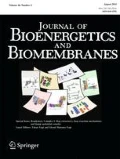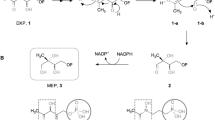Abstract
Mycobacterium tuberculosis represents one of the world’s most devastating infectious agents – with one third of the world’s population infected and 1.5 million people dying each year from this deadly pathogen. As part of an effort to identify targets for therapeutic intervention, we carried out the kinetic characterization of the product of gene rv1700 of M. tuberculosis. Based on its sequence and its structure, the protein had been tentatively identified as a pyrophosphohydrolase specific for adenosine diphosphate ribose (ADPR), a compound involved in various pathways including oxidative stress response and tellurite resistance. In this work we carry out a kinetic, mutational and structural investigation of the enzyme, which provides a full characterization of this Mt-ADPRase. Optimal catalytic rates were achieved at alkaline pH (7.5–8.5) with either 0.5–1 mM Mg2+ or 0.02–1 mM Mn2+. K m and k cat values for hydrolysis of ADPR with Mg2+ ions are 200 ± 19 μM and 14.4 ± 0.4 s−1, and with Mn2+ ions are 554 ± 64 μM and 28.9 ± 1.4 s−1. Four residues proposed to be important in the catalytic mechanism of the enzyme were individually mutated and the kinetics of the mutant enzymes were characterized. In the four cases, the K m increased only slightly (2- to 3-fold) but the k cat decreased significantly (300- to 1900-fold), confirming the participation of these residues in catalysis. An analysis of the sequence and structure conservation patterns in Nudix ADPRases permits an unambiguous identification of members of the family and provides insight into residues involved in catalysis and their participation in substrate recognition in the Mt-ADPRase.






Similar content being viewed by others
References
Abdelghany HM, Bailey S, Blackburn GM, Rafferty JB, McLennan AG (2003) Analysis of the catalytic and binding residues of the diadenosine tetraphosphate pyrophosphohydrolase from Caenorhabditis elegans by site-directed mutagenesis. J Biol Chem 278:4435–4439
Ames BN, Dubin DT (1960) The role of polyamines in the neutralization of bacteriophage deoxyribonucleic acid. J Biol Chem 235:769–775
Bessman MJ, Frick DN, O’Handley SF (1996) The MutT proteins or “Nudix” hydrolases, a family of versatile, widely distributed, “housecleaning” enzymes. J Biol Chem 271:25059–25062
Boto AN et al (2011) Structural studies of the Nudix GDP-mannose hydrolase from E. coli reveals a new motif for mannose recognition. Proteins 79:2455–2466. doi:10.1002/prot.23069
Cole ST et al (1998) Deciphering the biology of Mycobacterium tuberculosis from the complete genome sequence. Nature 393:537–544
de la Peña AH et al (2015) Structural and Enzymatic Characterization of a Nucleoside Diphosphate Sugar Hydrolase from Bdellovibrio bacteriovorus. PLoS One 10:e0141716. doi:10.1371/journal.pone.0141716
Dunn CA, O’Handley SF, Frick DN, Bessman MJ (1999) Studies on the ADP-ribose pyrophosphatase subfamily of the nudix hydrolases and tentative identification of trgB, a gene associated with tellurite resistance. J Biol Chem 274:32318–32324
Duong-Ly KC, Gabelli SB (2014a) Explanatory chapter: troubleshooting protein expression: what to do when the protein is not soluble. Methods Enzymol 541:231–247. doi:10.1016/B978-0-12-420119-4.00018-5
Duong-Ly KC, Gabelli SB (2014b) Explanatory chapter: troubleshooting recombinant protein expression: general. Methods Enzymol 541:209–229. doi:10.1016/B978-0-12-420119-4.00017-3
Eisenthal R, Danson MJ, Hough DW (2007) Catalytic efficiency and kcat/KM: a useful comparator? Trends Biotechnol 25:247–249. doi:10.1016/j.tibtech.2007.03.010
Emsley P, Lohkamp B, Scott WG, Cowtan K (2010) Features and development of Coot. Acta Crystallogr D Biol Crystallogr 66:486–501. doi:10.1107/S0907444910007493
Furuike Y, Akita Y, Miyahara I, Kamiya N (2016) ADP-Ribose pyrophosphatase reaction in crystalline state conducted by consecutive binding of two manganese(II) ions as cofactors. Biochemistry 55:1801–1812. doi:10.1021/acs.biochem.5b00886
Gabelli SB, Bianchet MA, Bessman MJ, Amzel LM (2001) The structure of ADP-ribose pyrophosphatase reveals the structural basis for the versatility of the Nudix family. Nat Struct Biol 8:467–472
Gouet P, Courcelle E, Stuart DI, Metoz F (1999) ESPript:multiple sequence alignments in PostScript. Bioinformatics 15:305–308
Interpro (2016) Interpro Protein sequence analysis & classification. EMBL-EBI. https://www.ebi.ac.uk/interpro/. Accessed 23 Jan 2016
Kang LW, Gabelli SB, Cunningham JE, O’Handley SF, Amzel LM (2003) Structure and mechanism of MT-ADPRase, a nudix hydrolase from Mycobacterium tuberculosis. Structure (Camb) 11:1015–1023
Krissinel E, Henrick K (2004) Secondary-structure matching (SSM), a new tool for fast protein structure alignment in three dimensions. Acta Crystallogr D Biol Crystallogr 60:2256–2268
Liu Y, Eisenberg D (2002) 3D domain swapping: as domains continue to swap. Protein Sci 11:1285–1299. doi:10.1110/ps.0201402
McDonald LJ, Wainschel LA, Oppenheimer NJJM (1992) Amino acid-specific ADP-ribosylation:structural characterization and chemical differentiation of ADP-ribose-cysteine adducts formed nonenzymatically and in a pertussis toxin-catalyzed reaction. Biochemistry 31:11881–11887
McLennan AG (2006) The Nudix hydrolase superfamily. Cell Mol Life Sci 63:123–143
Mildvan AS et al (2005) Structures and mechanisms of Nudix hydrolases. Arch Biochem Biophys 433:129–143
MOE CCGI (2016) Molecular Operating Environment (MOE), 2013.08. Chemical Computing Group Inc., Montreal
Moreno-Bruna B et al (2001) Adenosine diphosphate sugar pyrophosphatase prevents glycogen biosynthesis in Escherichia coli. Proc Natl Acad Sci U S A 98:8128–8132
Moss J, McDonald J (1994) Enzymatic and nonenzymatic ADP-ribosylation of cysteine. Mol Cell Biochem 238:221–226
Moss J, Zahradka P (1994) ADP-Ribosylation:metabolic effects and regulatory function. Mol Cell Biochem 138:1–253
Murshudov GN et al (2011) REFMAC5 for the refinement of macromolecular crystal structures. Acta Crystallogr D Biol Crystallogr 67:355–367. doi:10.1107/S0907444911001314
Navaza J (1994) AMoRe: an automated package for molecular replacement. Acta Crystallogr A50:157–163
O’Gara JP, Gomelsky MSK (1997) Identification and molecular genetic analysis of multiple loci contributing to high-level tellurite resistance in rhodobacter shphaeroides 2.4.1. Appl Environ Microbiol 63:4713–4720
O’Handley SF, Frick DN, Dunn CA, Bessman MJ (1998) Orf186 represents a new member of the Nudix hydrolases, active on adenosine(5′)triphospho(5′)adenosine, ADP-ribose, and NADH. J Biol Chem 273:3192–3197
Ooga T, Yoshiba S, Nakagawa N, Kuramitsu S, Masui R (2005) Molecular mechanism of the Thermus thermophilus ADP-ribose pyrophosphatase from mutational and kinetic studies. Biochemistry 44:9320–9329
Otwinowski Z, Minor W (1997) Processing of X-ray diffraction data collected in oscillation mode. Methods Enzymol 277:307–326
Patil AG, Sang PB, Govindan A, Varshney U (2013) Mycobacterium tuberculosis MutT1 (Rv2985) and ADPRase (Rv1700) proteins constitute a two-stage mechanism of 8-oxo-dGTP and 8-oxo-GTP detoxification and adenosine to cytidine mutation avoidance. J Biol Chem 288:11252–11262. doi:10.1074/jbc.M112.442566
Perraud AL et al (2001) ADP-ribose gating of the calcium-permeable LTRPC2 channel revealed by Nudix motif homology. Nature 411:595–599
Robert X, Gouet P (2014) Deciphering key features in protein structures with the new ENDscript server. Nucleic Acids Res 42:W320–W324. doi:10.1093/nar/gku316
Song EK, Park HJ, Kim JS, Lee HH, Kim UH, Han MK (2005) A novel fluorometric assay for ADP-ribose pyrophosphatase activity. J Biochem Biophys Methods 63:161–169
Tong L, Lee S, Denu JM (2009) Hydrolase regulates NAD+ metabolites and modulates cellular redox. J Biol Chem 284:11256–11266. doi:10.1074/jbc.M809790200
WHO (2016) Global Health Observatory GHO data. http://www.who.int/gho/tb/epidemic/cases_deaths/en/
Wolff KA, de la Peña AH, Nguyen HT, Pham TH, Amzel LM, Gabelli SB, Nguyen L (2015) A redox regulatory system critical for mycobacterial survival in macrophages and biofilm development. PLoS Pathog 11:e1004839. doi:10.1371/journal.ppat.1004839
Yoshiba S et al (2004) Structural insights into the Thermus thermophilus ADP-ribose pyrophosphatase mechanism via crystal structures with the bound substrate and metal. J Biol Chem 279:37163–37174
Zha M, Zhong C, Peng Y, Hu H, Ding J (2006) Crystal structures of human NUDT5 reveal insights into the structural basis of the substrate specificity. J Mol Biol 364:1021–1033
Acknowledgments
This work was partially supported by NIGMS grant GM066895 (L.M.A.), grant J-497 from the Kate Jeffress Trust Foundation (S.F.O.), Cottrell College Science Award CC5180 from Research Corporation (S.F.O.), NIGMS AREA grant GM066715 (S.F.O.), and NCI grant P50 CA062924 - SPORE in Gastrointestinal Cancer (S.B.G). S.B.G. is an Alexander and Margaret Stewart Cancer fellow.
Author information
Authors and Affiliations
Corresponding author
Ethics declarations
Competing interests
The authors declared no competing interests.
Additional information
Suzanne F. O’Handley, Puchong Thirawatananond and Lin-Woo Kang contributed equally to this work.
Rights and permissions
About this article
Cite this article
O’Handley, S.F., Thirawatananond, P., Kang, LW. et al. Kinetic and mutational studies of the adenosine diphosphate ribose hydrolase from Mycobacterium tuberculosis . J Bioenerg Biomembr 48, 557–567 (2016). https://doi.org/10.1007/s10863-016-9681-9
Received:
Accepted:
Published:
Issue Date:
DOI: https://doi.org/10.1007/s10863-016-9681-9




